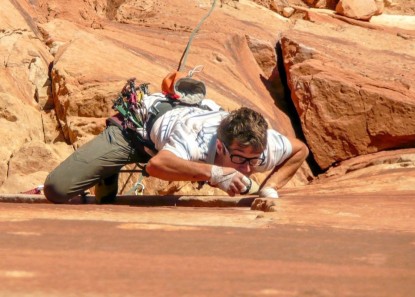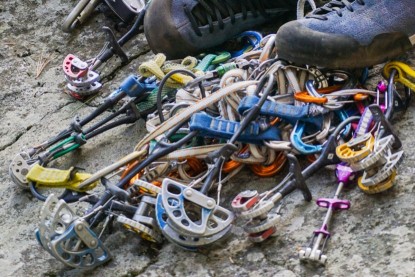Likes
Rock Empire makes the least expensive cams on the market. You can outfit yourself with a rack of Robots for a fraction of the cost of other cams that we tested. The cams are of solid construction and are quite durable. The u-stems are made of the thickest cables we've seen on u-stem cams and the cam lobes are durable and solid.
Despite the thickness of the u-stem cables, they are still flexible enough for horizontal placements and the sling is extendable spectra providing a bit of extension and helping to cut down on the walking of the cams. The trigger is easily operated and the action is fairly smooth.
Dislikes
The first and most readily apparent issue is a design flaw and primarily affects the larger size cams (# and ). To put it simply, the middle lobes on the Robot Cams are just flat out too close together effectively negating any stabilization gained from properly spacing the lobes. In the smaller units, they are immediately side by side, almost touching, creating a TCU-like effect. In the larger units, the middle two lobes are slightly separated but only minimally so. While you'd think that this squeezed in design would create a narrower cam head, we found that the heads on these guys were just as wide as a BD Camalot. No advantage in shallow placements to be found here. The convenience of placement aside, the main problem with having the cam lobes so close together, is that the larger cams have a major tendency to walk, creating potentially hazardous scenarios. Though the smaller units do walk a little, in most cases it is significantly less than the larger units, and not much more than some other cams I've used.
Another contributing factor to the Robot's tendency to walk is that the springs seem to be a bit weak, particularly (again) in the larger units. The springs just don't provide enough pressure to hold the unit solidly in place. When placed in a solid placement, where my # Camalot could hold a falling truck, my largest Robot Cam seems a bit shaky. Not very confidence inspiring 10ft after the placement with no pro between. Here again, the smaller units do not seem to suffer from as severe a case of "wimpy springs."
We also found these cams to be difficult to place and clean in all but the most straightforward placements. Their low range and super close together lobes don't make for a very forgiving unit in terms of squeezing into awkward placements, and the cams tend to walk themselves into sticky spots for your second to clean. To top it all off Rock empire's Robot Cams are among the heaviest of all the cams that we tested, only to be outdone by Omega Pacific's Link Cam and Metolius' Supercam both of which have far greater ranges than any of Rock Empire's units.
Best Application
Trad climbers on a super tight budget rejoice: here is something that will get you out on the rock. Not recommended for inexperienced gear placers due to the precision and caution that needs to be taken when using these cams.
Personal Stories
I got a full set of these for super cheap and they sat on my rack as a compliment to my Camalots #.-. I had a fairly OK experience with them but after two seasons on them, the damage they were doing to my nerves was becoming apparent. Despite having fallen onto all of them, I didn't find myself believing in their ability to keep me safe after seeing them walk, wiggle and invert so many times. It was affecting the extent to which I would push myself and created a mental block. I replaced them all the end of last summer and never looked back. It could be that they became less confidence inspiring over time, or that I just became a smarter climber. Either way, I don't find them to be bomber enough for my liking these days.
Value
These are the least expensive cams on the market, ranging from about $40-45 each. If you are on a shoestring budget these are the cams for you. There are, however, some much better options for not much more so it might be best to save for a little longer and pick up something of higher quality.




